 |  |
| The English Duchy ay the foot of Etna
The cards, the places, the memory ... | Bronte's history, together |  |
| You are in: Home-> History-> Horatio Nelson -> The seven dukes of Bronte |
A short history of Bronte The seven dukes of Bronte (1799 / 1981)
| 1° - Horatio Nelson (1799 - 1805) | 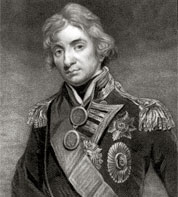 Admiral Horatio Nelson (29.9.1758 - 21.10.1805), son of Anglican pastor of Burnjam-Thorp (Norfolk), first Duke of Bronte. He obtained the title and the territory – “in perpetual” - in 1799 from the “grateful” Ferdinand of Bourbon, to whom he had saved the life and the throne. Admiral Horatio Nelson (29.9.1758 - 21.10.1805), son of Anglican pastor of Burnjam-Thorp (Norfolk), first Duke of Bronte. He obtained the title and the territory – “in perpetual” - in 1799 from the “grateful” Ferdinand of Bourbon, to whom he had saved the life and the throne.
He had expressed the intention to make of the estate “the happier place of Europe” hoping that all the Sicilians would have blessed the day in which he had been sent to them. He started the restructure of the ancient Abbey entrusting the job to Andrea Graefer, but he never did put foot in his Ducea. After his death the feud passed to his brother William Nelson. In spite of the fact that the admiral had a daughter (Orazia) from Lady Hamilton, and although the “Diploma of donation” of the feud concurred to name heir anyone he wanted,  practically he left nothing neither to Orazia neither to her mother defined in his testament «widow of the honorable knight Guglielmo Hamilton, conferred with the title of the most honourable order of the bath». practically he left nothing neither to Orazia neither to her mother defined in his testament «widow of the honorable knight Guglielmo Hamilton, conferred with the title of the most honourable order of the bath».
| 2° - William Nelson (1805 - 1835) | 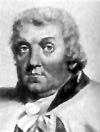 The Reverend William Conte Nelson (1757 - 1835) «and Viscount Merton of Trafalgar, and Merton on Sury County and United Kingdom of Great Britain, and Ireland, Baron Nelson of Nile and Hilborough of Norfolk County on the same United Kingdom, Duke of Bronte in this Kingdom of Sicily», angligan shepherd, elder brother of Admiral Horatio Nelson, received the title of Duke of Bronte and the immense Ducea in inheritance with testament of 10 May 1803. The Reverend William Conte Nelson (1757 - 1835) «and Viscount Merton of Trafalgar, and Merton on Sury County and United Kingdom of Great Britain, and Ireland, Baron Nelson of Nile and Hilborough of Norfolk County on the same United Kingdom, Duke of Bronte in this Kingdom of Sicily», angligan shepherd, elder brother of Admiral Horatio Nelson, received the title of Duke of Bronte and the immense Ducea in inheritance with testament of 10 May 1803.
In addition to other heirs, the bulk of the property was assigned to him by Nelson together with his nephew William Haslewood, son of his sister Susanna. 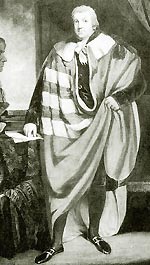 William Nelson, also like his brother Horatio, never set foot in the Duchy, never visiting and enjoying for 30 years the benefits and income (large sums received by remittances from the banks) without even knowing what were the characteristics of the immense territory and the poor conditions of the population exploited by him who lived there ("my vassals and subjects of Bronte", so he defined it in a letter). William Nelson, also like his brother Horatio, never set foot in the Duchy, never visiting and enjoying for 30 years the benefits and income (large sums received by remittances from the banks) without even knowing what were the characteristics of the immense territory and the poor conditions of the population exploited by him who lived there ("my vassals and subjects of Bronte", so he defined it in a letter).
Consider that in the only two years 1808-1809 William Nelson received from the Palermo banker Abraham Gibbs remittances of a good 25.759.2 onze (over 1 and a half million euros). A year earlier, however, he wrote to the Marquis Antonio Forcella complaining that «having given the account to the executors of the late Lord Nelson, and having made two annual payments of Lady Hamilton's annuity,» had «paid much more than what he had received so far from Sicilia.» The Reverend William also wanted to include in his coat of arms that of the City of Bronte. But Forcella, in some way, extinguished the enthusiasm:
«About the arms of Bronte - he wrote to him in 1807 - I must point out that here generally the Cities, Lands and Castles have nothing but the weapons of the Black Eagle, which is in real arms again, and Bronte has this for his weapons.
 It will depend on the pleasure of V. E. if he wants to ask for his power to be involved in his weapons.» It will depend on the pleasure of V. E. if he wants to ask for his power to be involved in his weapons.» A few years later, in 1819, condemning remarks, turmoil and continuous local judicial litigation, responding to some Brontesi who had denounced him overwhelms and bullying by his administrators wrote:
«Do not want to force me to regard Bronte as a turbulent, restless people; or even as peoples who desire to diminish the value of that noble gift, with which the generosity of His Majesty has spontaneously deigned to honor the heroic my brother, to remunerate the services rendered by him to the Kingdom of Sicily, and which His Majesty It is pleased to confirm in my person.» «I try - he concluded - the greater and more sincere desire to assure them Lords of craving that I have to contribute to their happiness, but when a due care of my interests will allow it» (Nelson Archives, vol 316, 299). For the Bronte people that day, of course, it never came. The Reverend William happily continued to exploit them for another 16 years until his death. At his death the Ducea, by succession testamentary, step to his only surviving daughter Charlotte Mary Nelson.
| 3° - Charlotte Mary Nelson (1835 - 1873) | 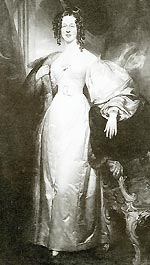 Charlotte Mary Nelson (1787-1873), baroness of Bridport, nephew of Admiral Nelson, daughter of the Reverend William. Charlotte Mary Nelson (1787-1873), baroness of Bridport, nephew of Admiral Nelson, daughter of the Reverend William.
From 1838 to 1847 he claimed to have won it (the Court on 12 March 1847 confirmed his right to property) a lengthy judicial dispute against the claims of Orazio Bolton (nephew of Susannah, sister of the Admiral) who claimed possession of the Ducea. She was, until now, the only woman to bear the title of "Duchess of Bronte". Charlotte Mary, showing a first, although venal, interest in these estates so far but still profitable, was the first family to visit (even for a very short period) the great fief donated by King Ferdinand to his uncle Horatio and to bring you also the flag and the surname of the Hood (since 1810 was married, in fact, to Samuel Hood, second viscount of Bridport, scion of famous and glorious ancestors of the English navy). 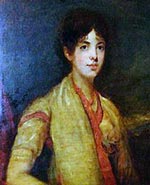 Rich and accustomed to the luxuries of London life, he found primitive and wild conditions of life. Rich and accustomed to the luxuries of London life, he found primitive and wild conditions of life.
Also shaken by the difficulties of the journey in a litter (a rudimentary sedan suspended between two mules), the black volcanic landscape, the danger that Etna aroused and the stories of the atrocities committed by the Bronte in 1820, immediately escaped from Maniace swearing that never he would return there (on the right his signature). And so it was. He managed the properties by relying on the Thovez (Philip, Henry and William). In 1857, the Great and New Hospital of Palermo, the previous feudatory owner of the territory and of the Bronte area, gave it the archive in its possession (judicial and administrative documents and other documents) concerning the lands of Bronte and the abbeys of Santa Maria of Maniace and S. Filippo di Fragalà inherited from her. The archive (now called Nelson Private Archives) allows you to learn about the life and administration of the Duchy and in particular all legal disputes and litigation between the University of Bronte and the two feudal lords (the Hospital, first, and the Duchess , after) that lasted for over 350 years. In the same Archive we also find a malevolent "portrait" of the Duchess described as "overbearing by instinct, (...) out of innate avarice for the good of others, greedy and rapacious even to the detriment of her own relatives, inflexible, inexorable" (Archivio Nelson, vol. 212-C page 145).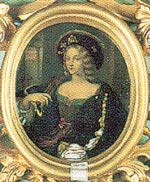 In 1860, after the futile attempt made in 1854 by the Bourbon King Ferdinand II to appoint a "definitive and unappealable referee" but above all after the tragic events of Augustt of the same year, Charlotte Mary Nelson and the Municipality of Bronte, hoping to reconcile souls and put an end to the continuous, innumerable disputes and tensions, they entered into a transaction, desired and completed by Antonino Cimbali, with which the Duchy returned to the Municipality of Bronte about half of its territory (although mostly woods, lava soils and stony ground with some arable land). On the death of Lady Carlotta Maria Nelson, in 1873, the property and title passed to the eldest, Lieutenant Colonel Alexander Hood, for whom and his male heirs in perpetuity, the Duchess since 1855 had asked SM King the Bourbon "the approval for the establishment of a majorasco  enclosing the entire duchy and land of Bronte". enclosing the entire duchy and land of Bronte". The other daughters of Lady Carlotta, Maria Sophia, Carlotta, Giovanna Sophia, Luisa and Francesca Carolina had already been widely endowed by the rich heiress.. Lady Carlotta also imposed on her son to add to his surname also that of Nelson.
| 4° - Alexander Nelson Hood (1873 - 1904) | 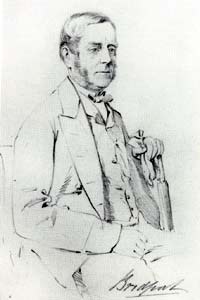 Alexander Nelson Hood, baron Bridport (1814 - 1904), great-grandson of Nelson, son of Charlotte Mary Nelson, the III duke. Alexander Nelson Hood, baron Bridport (1814 - 1904), great-grandson of Nelson, son of Charlotte Mary Nelson, the III duke.
Married to a cousin of Duke Wellington (Napoleon's victor), Lady Mary Penelope (1817-1884), daughter of Arthur Hill third Marquess of Downshire, with her next to "Nelson" the surname "Hood" also appears for the first time. He had six sons and four daughters:
- Arthur Wellington Alexander Nelson Hood, 2nd Viscount Bridport (1839 - 1924), eldest son who legally inherited his father's British titles but not the Duchy of Bronte;
- Horatio Nelson Sandys Hood (1843 - 1881);
- William Nelson Hood (1848 - 1921);
- Alexander Nelson Hood, the future 5th Duke of Bronte (1854 - 1937) who inherited the Duchy from his father and was the first of the family to settle in Maniace;
- Alfred Nelson Hood (1858 - 1918);
- Victor Albert Nelson Hood (November 14, 1862 - Taormina May 1, 1922), younger brother of the V Duke, lived for 25 years in Australia (1913) and later served his elder brother in the administration of the Duchy. He is buried in the small English cemetery near the Castle. The four daughters were:
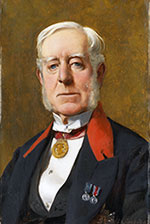 - Nina Maria Hood (died June 5, 1923); - Nina Maria Hood (died June 5, 1923);
- Adelaide Fanny Hood (Dulverton, Somerset, 1850 - Folkestone, Kent, 1927);
- Rosa Penelope Hood (1852 - 1922) who died in the Villa La Falconara in Taormina, in whose garden she was initially buried, before being transferred to the ducal cemetery of Maniace following the sale of the Villa;
- Mary Hood (June 4, 1846 - April 6, 1909). Sir Alexander Nelson Hood was the Duke of the turning point, the colonizer, the first to show interest in the immense fiefdom and to deal directly with its management (he had already visited the Duchy in 1864), to improve it by introducing innovations and new crops. Distrusting its administrators, (in that period alternated Samuel Grisley, monsieur Louis Fabre and Charles Beek), he sent to Maniace his eighth son Alexander (hardly seventeen years old, future 5th Duke) to live there stably and guard in loco the interests of the family.  In 1883 Alexander Nelson Hood "as perennial merit" was appointed honorary president of the Deputation who governed the life of the Real Collegio Capizzi; the duchino, of his twenty-nine year old son, was named honorary deputy. In 1883 Alexander Nelson Hood "as perennial merit" was appointed honorary president of the Deputation who governed the life of the Real Collegio Capizzi; the duchino, of his twenty-nine year old son, was named honorary deputy.
In 1885 Queen Victoria appointed him the prestigious Order of the Bath naming him Knight Commander.
During the terrible cholera epidemic which struck Bronte in 1887, the Duke distinguished himself for the help given to the Bronte area by making 10 wheat bodies available to the Commune. In 1883-84 his son Alexander attempted to divert the stretch of the Bronte-Maletto-Randazzo railway line up to Maniace. He did not succeed and after the opening of the Railway in 1896 he had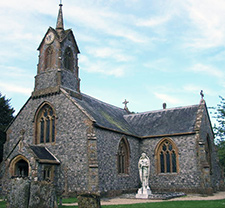 a "private road" built at his own expense from Maniace to the Maletto railway station. a "private road" built at his own expense from Maniace to the Maletto railway station. Alexander Nelson, Viscount Bridport, Duke of Bronte ceased to live in a Royal Lodge a few kilometers from Windsor Castle at the age of 89, on 4 June 1904. He was buried in the churchyard of Cricket Saint Thomas Church, in the picturesque Somerset countryside, home of his parents Samuel Hood and Charlotte Mary Nelson, 3rd Duchess of Bronte. A life-size white marble monument depicting St. Michael the Archangel was erected over his tomb. The British noble titles went to the eldest son Arthur Wellington Alexander Nelson Hood, while the Duchy and the title of Duke of Bronte, as per will deposited on July 9th, were transferred to the fourth son the Duchin Alexander Nelson Hood. To him the son has dedicated the Obelisk in the highest point of “Sierra di Mergo”.
| 5° - Alexander Nelson-Hood (1904 - 1937) | 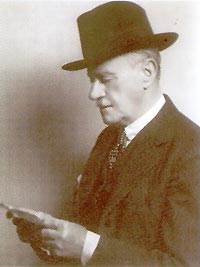 The Hon. Sir Alexander Nelson-Hood, V Duke of Bronte, Grand Officer of the Crown of Italy, Treasurer of Her Majesty the Queen of England, Viscount Bridport, born in the Royal Palace of Cumberland Lodge Windsor on June 28, 1854, visited for the first time the Ducea, very young, in 1868. The Hon. Sir Alexander Nelson-Hood, V Duke of Bronte, Grand Officer of the Crown of Italy, Treasurer of Her Majesty the Queen of England, Viscount Bridport, born in the Royal Palace of Cumberland Lodge Windsor on June 28, 1854, visited for the first time the Ducea, very young, in 1868.
The peasant and literary gentleman has been defined.
At the age of 19, the management of the fiefdom, he lived there permanently between Maniace and Taormina until his death, enjoying the property and bringing new elements of land reclamation and transformation. So he described his first years of life at the Castle: «My task: to administer a large territory, young as I was, devoid of experience, ignorant of people and their ways, with an uncertain knowledge of the language, was not the most simple.
However, I worked hard and, working sometimes until one o'clock in the morning, or later, I held the accounts, supervised the work out, and took care of the correspondence and administration for a certain number of years, practically without help.»  "It seems - writes Nunzio Galati - that did not create problems, indeed, it was natural to take the pickaxe, the hoe or a club giving us under to get soaked with sweat and return to the castle so ruffled and dirty as to seem a tenant. And during the harvest he always entered the vat of the millstone to press the grapes mixed among his employees. " "It seems - writes Nunzio Galati - that did not create problems, indeed, it was natural to take the pickaxe, the hoe or a club giving us under to get soaked with sweat and return to the castle so ruffled and dirty as to seem a tenant. And during the harvest he always entered the vat of the millstone to press the grapes mixed among his employees. "
His administrators were the cav. Charles Beek, Mr. Edwin Hughes, Major Richard Forsyth Gray and Mr. George Dubois Woods. He was the first to be buried in the small English cemetery of the Duchy. Smart and refined, he has left us some books including "Tales of Old Sicily" (London, 1906); “Sicilian Studies", stories and essays related to life in Sicily (George Allen & Unwin, London 1915), but above all a memoir - "La Ducea di Bronte" (The Duchy of Bronte) -, a "family diary", published recently, which represents a true mine of detailed information on the history and management of the feud, on the management criteria and on the types of crops but also on the customs and character of the Bronte population. Fascinated by Venice and its history he also wrote a novel of Venetian setting, "Adria a Tale of Venice" (London 1904), dedicated to his friend and traveling companion W. Sharp, with whom he shares his love for the lagoon city . Alexander Nelson Hood rules great fief for a long time with love and passion, bringing you continuous innovations and improvements. In his time - the feud was entrusted to him by his father when he was only 19, in 1873 - the Ducea reached its peak. In particular, he also cared for the planting of precious vines. With the dream of bringing Sicily to the forefront of the world in the production and marketing of great wines and brandy participates in some national exhibitions. However, I will not be able to overcome the growing difficulties caused by the high production costs and the spread in the Maniace vineyards of Filossera. Among other works he built the road that leads from the Ducea to the Maletto railway station and the other from Bronte to the Ricchisgia and Marotta districts which were then part of the immense feud. |
| Lover of Greek literature and myths, he was a ductile intelligence, with interests as well as poetry and literature also in the fields of economics, sociology and anthropology. La Ducea also became a literary parlor and buen retiro of English poets, writers and artists including William Sharp (dead and buried in Maniace), D. H. Lawrence, F. Marion Crawford and Frances Elliot. The memories, the impressions and the judgments on the places and on the brontesi of these literati, poets, musicians, great travelers who, guests to Maniace of the descendants of Horatio Nelson, visited Bronte from 1801 to 1920 were not always flattering for us Bronte. 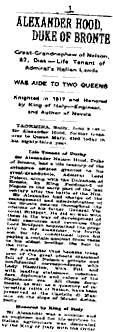 For his commitment to the people of Messina struck in 1908 by a fatal earthquake, for interventions on a personal basis but especially for the organization of centers for the distribution of milk and bread, of ambulatories and to offer hospitality to refugees in Taormina, the Duke Alexander Nelson-Hood who was already Commander of the Order of the Crown of Italy for merits acquired in the field of agriculture was very deservedly elevated by the King to the rank of Grand Officer. For his commitment to the people of Messina struck in 1908 by a fatal earthquake, for interventions on a personal basis but especially for the organization of centers for the distribution of milk and bread, of ambulatories and to offer hospitality to refugees in Taormina, the Duke Alexander Nelson-Hood who was already Commander of the Order of the Crown of Italy for merits acquired in the field of agriculture was very deservedly elevated by the King to the rank of Grand Officer.
The fifth duke died eighty-three on June 1, 1937 in his villa in Taormina (in the photo on the right the news of the death reported by the New York Times). Having never married he left no direct heirs. At his death the Ducea passed to one of his great-grandsons, foster son, Rowland Arthur Herbert Nelson-Hood viscount Bridport (second son of his brother, Arthur Wellington Alexander) he appointed universal heir and executor of testament with the testament of September 24, 1935.
| 6° - Rowland Arthur Herbert Nelson-Hood (1937 - 1969) | 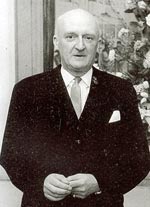 Rowland Arthur Herbert Nelson-Hood, Born the 22.5.1911 in British Columbia (Canada). He inherits the Duchy from his uncle in 1937. Rowland Arthur Herbert Nelson-Hood, Born the 22.5.1911 in British Columbia (Canada). He inherits the Duchy from his uncle in 1937.
In July 1969 he was struck down by a hearth attack on the 26th of July 1969 at Maniace and was buried in the small cemetery of the Duchy. During the 32 years in which he ran the feud he was successful - even if it wasn't always easy – in becoming well-liked and estimated. He was able to remove from himself that image and attitude of “landlord” that had characterized several his predecessors. Even if the times were mature to dismantle the “last Sicilian feud”, the 6th duke, on the tracks of h predecessor, brought remarkable improvements in the management of the property and in the conditions of the peasants. He constructed the first school, a flour mill, paid an obstetrician and a doctor, made the water available to all and improved the conditions of roads and bridges. Nevertheless, Carlo Levi, in 1950 wrote of the Duchy «... example of the most absurd historical anachronism, of the persistence of a lost feudal world and of the futile attempts made by the peasants in order to exist like men.» His years were, in the newborn Republic, of great social transformations, the agrarian reform, the occupations of lands and the struggle that the peasants of Bronte, Maniace and Maletto supported from the ’49 to the ’56 for the application of the reform and the division of the ducal large landed estate. From 1963 to 1965, after decades of fights, what remained of the immense feud, donated to Nelson by the Bourbons, was divided in small lots (for a total of 6,593 hectares) and assigned to the peasants. To the Duchy remained only a little more than 200 hectares. The 6th Duke married Pamela Aline Mary Baker in 1934 and divorced her in 1945; subsequently, in 1945, he married Sheila Jeanne Agatha van Meurs (died 1996) with whom he had Alexander Nelson Hood (born 1948), 7th Duke of Bronte. Its administrators were Mr. George Niblett, Mr. Charles Lawrence Hughes and Mr. Frank Edward King. In the photo on the left, the British Passport issued in 1955 by the British Consulate of Palermo to the right honorable Rowland Arthur Herbert Nelson Hood Viscount Bridport, land owner by profession, height 6 ft. 3 in., Blue eyes, white hair, special peculiarities: tattoo (dragon) in the right forearm.
| 7° - Alexander Nelson-Hood (1969) | 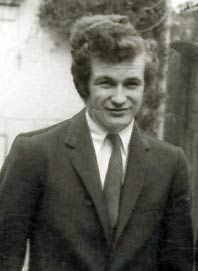 Alexander Nelson-Hood, born in London on March 17, 1947, is the current Duke of Bronte, the VII, scion of the Nelsons, Hoods, Bridports, historical names linked to the history of the British navy. Alexander Nelson-Hood, born in London on March 17, 1947, is the current Duke of Bronte, the VII, scion of the Nelsons, Hoods, Bridports, historical names linked to the history of the British navy.
When he inherited it, the Duchy was not anymore one of largest Sicilian landed estates; after the transaction del the 1861 and the application of the agrarian reform of the years 1963-65, what remained were only the prestigious buildings and a few hundreds of hectares of fertile land, cultivated as orchards. Before inheriting it, two years earlier, in 1967, Alexander Nelson Hood was an official of an important British financial institution (Kleinwort Benson, where he dealt with business relations with Europe and particularly with France, Italy, Spain ). He immediately showed that he had no passion or interest in continuing to live in the Duchy that had belonged to Nelson. In the twelve years of his "reign" he proceeded to sell all the remaining properties and, in September 1981, also the complex of the ancient abbey which was purchased by the Municipality of Bronte for one billion and seven hundred and fifty million lire (of which 950 for the "Castle" proper and for the land; 237 for the other buildings; 570 for the furniture, relics, paintings, and any other movable thing existing in the "Castle"). 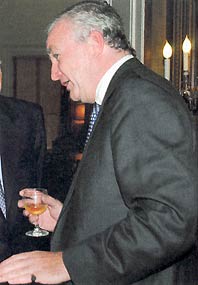 The VII Duke of Bronte went to live in Switzerland. The VII Duke of Bronte went to live in Switzerland.
«He was - writes the Irish historian Lucy Rial (The revolt. Bronte 1860, p. 244) the first member of the family who spent his childhood in Sicily, and grew up in Maniace and Rome, except for the period of studies in England, at Eton College, and at the Sorbonne in Paris. After his father died in 1969, he decided to sell the property.» After the sale of the Ducea, Alex Bridport, "the most Sicilian of all the Dukes of Bronte", left Bronte and did not return there for thirty years: he dedicated himself to his activity in the field of financial intermediation, moving to the service of Chase Manhattan in Geneva and Shearson Lehman Brothers in New York, and then founded, in 1991, a financial services company in Geneva, Bridport & C. s.a. «In 2010, - continues Rial - Bridport Investor Services had a net capital of 17 million Swiss francs, with a sales volume of over 31 billion Swiss francs and offices in Geneva, Zurich and the island of Jersey.
If the owners of investment banks, as is generally believed, are the nobility of the 21st century, then the 7th Duke of Bronte can say that he has finally realized his family's dream.» In a conversation he had with the Rial on July 15, 2011, Viscount Bridport explained how his decision to sell the Ducea was a foregone conclusion. At the time of his father's death he was very young, just twenty-one, and had a career in the City of London ahead of him and ambitions which did not include running an estate in Sicily. In any case, in the 1970s the property had undergone a significant reduction and was burdened by substantial debts. «Large in size, uncomfortable and with considerable running costs, always too far away to be an English country house and located in a place where there was not much entertainment, the castle of Maniace was now almost exclusively a cumbersome burden.» Today the only property that the heirs of Nelson continue to own in Bronte is the small English cemetery located a few steps from the Ducea. Many of their ancestors rest there and represents the only truly emotional bond with the ancient Ducea inherited from the Admiral. Built in 1898 for the Nelson family, it houses eight tombs, including the one of the romantic poet William Sharp who died in Bronte. 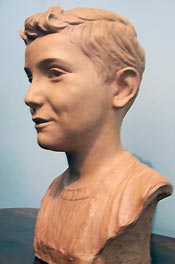 Although tiny and symbolic, the possession of the small cemetery allows to somehow preserve the juridical and moral right to the feudal title of "Duke of Bronte". Although tiny and symbolic, the possession of the small cemetery allows to somehow preserve the juridical and moral right to the feudal title of "Duke of Bronte".
This only property of the heirs of Horatio Nelson, today is in concession to the municipality of Maniace for a period of 10 years, for the promotion of tourism. In the photo on the right a terracotta bust, preserved in the Nelson Museum, portrays the 7th Duke, Alexander, still a child. The Ciclope of December 5th 1948 wrote that «The blond and plump heir, the duchino Alessandro Nelson Hood, born in London on March 17th of this year, was presented to the large crowd of Ducea employees in one of their families». |
|
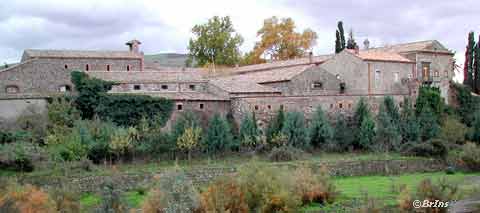
One general view of the ancient Benedictine abbey risen around 1173 in Maniace, probably on the ruins of one pre-existent “basiliana” construction, for will of Queen Margherita. Today it is called Nelson Castle. | 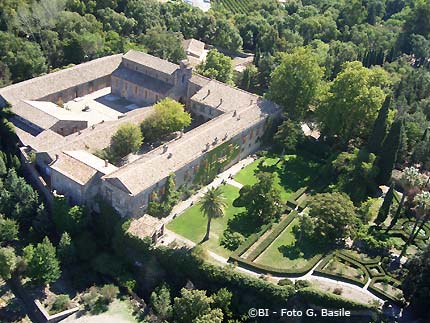 Over an aerial view of the Duchy’s complex (the so-called “Nelson Castle”). The right wings (the former exclusive apartments that now accommodate the Nelson Museum), overlook the planned inner garden by Andrea Graefer, first administrator of the Duchy nominated by Nelson. (Photo G. Basile). | 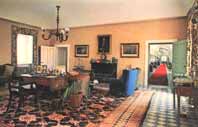 | 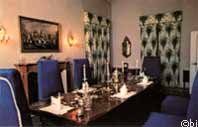 | 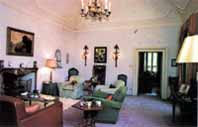 | 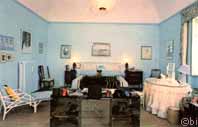 | 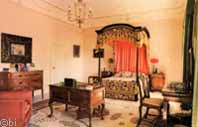 | 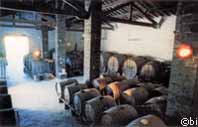 | These photos date back to the period during which the Duchy was still the residence of the current Duke of Bronte, Alexander Nelson-Hood. They are taken, after the Nelson decision to abandon the territory and the Duchy after almost two centuries, from a brochure created by a London companyy to advertise their sale. The rooms, then purchased in 1981 by the Municipality of Bronte, now constitute the Nelson Museum but many furnishings, paintings, furnishings and even important documents such as letters, diaries and other visible here no longer exist. They went missing because they were not sold or disappeared when the Duchy, expropriated by the fascist regime, was entrusted to the Agricultural Development body or sold before delivery to the Municipality or given by compliant agents or even stolen (such as the 17th century walnut table century of the dining room in the second photo, stolen in 1984).
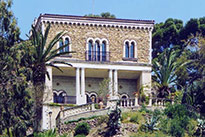 In the two photos on the right La Falconara, the residence of the Dukes of Bronte in Taormina, built by them in 1911. In the two photos on the right La Falconara, the residence of the Dukes of Bronte in Taormina, built by them in 1911.
Lucy Ryal (Under the Volcano: Empire and Revolution in a Sicilian Town, 2013) writes that the V Duca, 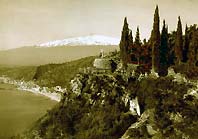 «Alexander Nelson Hood also built a villa in Taormina, helping to develop the city as a luxury resort and holiday resort for wealthy homosexuals in northern Europe» and that the writer Robert Hichens, frequent guest of the Duke in Maniace and Taormina, «was also very interested in Alec Hood». King George V and Queen Mary stayed in the villa in 1925 with Prince George and Princess Victoria. «Alexander Nelson Hood also built a villa in Taormina, helping to develop the city as a luxury resort and holiday resort for wealthy homosexuals in northern Europe» and that the writer Robert Hichens, frequent guest of the Duke in Maniace and Taormina, «was also very interested in Alec Hood». King George V and Queen Mary stayed in the villa in 1925 with Prince George and Princess Victoria.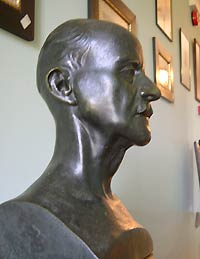
On the right, the bronze bust of V Duke Alexander Nelson-Hood, who died, 83 years old, in this villa on 1 June 1937: "The bronze bust is mine, made by the young sculptor from Taormina Enrico Licari - unsatisfactory in similarity, except in profile, perhaps."
(Alexander Nelson-Hood, "The Duchy of Bronte")
|
|  | 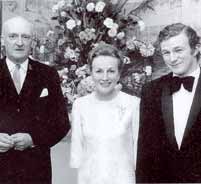 | A rare photo of the wedding of the present Duke of Bronte (the 7th), Alexander Nelson-Hood with Linda Jacquelyn Paravicini. The photo to the right was taken in London in March 1969 during the festivities for his 21st year of age.
To the left of Alexander the parents, the 6th Duke of Bronte, Rowland Arthur Herbert Nelson-Hood, and the mother, the duchess Sheila Jeanne Agate van Meurs (of Dutch origin). | 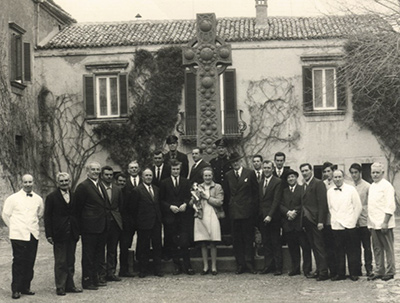 | The young duke Alexander, the mother and the 6th duke Rowland Arthur Herbert Nelson-Hood pose with the employees in the courtyard of the Castle, in front of the Cross dedicated to their ancestors. 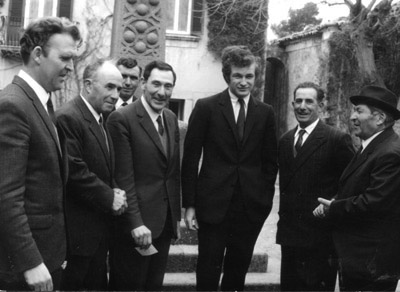
The 7th Duke of Bronte posed with the administrative staff of the Duchy: the first one on the left is mister King (the last administrator); to right of the duke a very young Giuseppe Carastro (recently deceased). |
|
|
 The current Duke of Bronte and Viscount Bridport, Alexander Nelson Hood, with his Peregrine children Alexander Nelson Hood (in the center, born 30/8/1974, had with Linda Jacqueline Parravicini, future heir to the titles of Duke of Bronte and Viscount Bridport ) and Anthony Nelson Hood (born 7/1/1983, with Nina Lincoln). The 7th Duke, Alexander Nelson Hood, divorced Linda in 1979 and then Nina in 1999. The photo probably dates back to the day of the wedding of Peregrine, friend of Prince William and Prince Harry, to Serena Nikkhan, executive fashion director of British Vogue. They were married on 8 June 2013 at the small church of St John the Baptist in Charlton Park, Malmesbury, Wiltshire, home of Peregrine's mother, the Countess of Suffolk and Berkshire. |
|
|
|